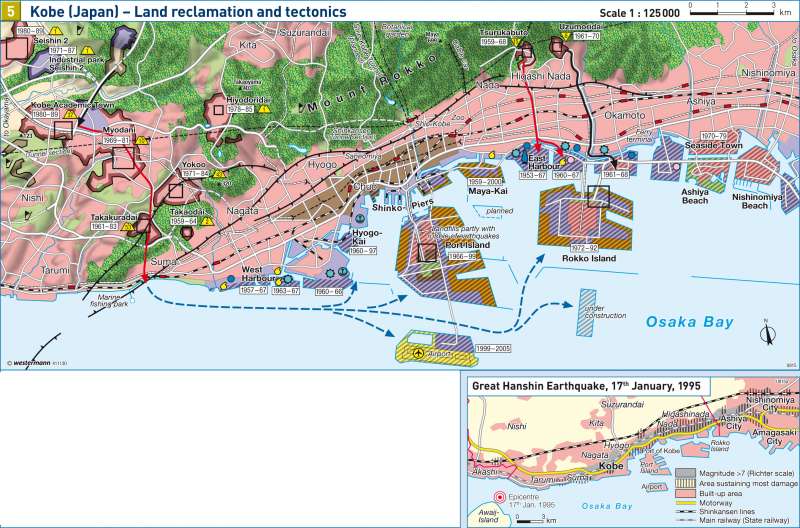Kobe (Japan) — Land reclamation and tectonics
China and Japan
978-3-14-100790-9 | Page 111 | Ill. 5

Information
The extreme shortage of land in the conurbations of Japan, which is also noticeable everywhere in Kobe, and the constantly growing demand for land and deep water for its expanding port industries, have led since the mid-1950s to the increasing reclamation of land from the sea by means of landfill. The Japanese call this reclaimed land "umetate-chi" (umetate = fill in and build; chi = land, earth). This form of landfill, which differs from the land reclamation in the Dutch polders on the North Sea coast, is only possible on a large scale thanks to highly modern technology.Characteristic of Japan is the close integration of the landfill areas with efficient port facilities. The island nation compensates for its lack of resources with the aid of rational facilities for the import of raw materials and their on-the-spot processing. In other words, Japan's economic success is thanks, not least, to modern port development. The functional change from trading to manufacturing-oriented ports set in at an early stage, as is demonstrated by Kobe, with its 1.5 million inhabitants, which today stretches along the foot of the Rokko mountain range as a two to four kilometre wide and 16 kilometre long ribbon city.
Land Reclamation in Kobe
The main reasons for the continuously increasing reclamation of landfill areas off the coasts of Japan, beside the general land shortage and the associated rapid increase in land prices, are its attractiveness as a location for industry — with deep-water ports, the relatively rapid and cheap provision of large commercial and industrial sites with possibilities for further spatial expansion — the relative environment-friendliness of such micro-locations, and improvements in the transport infrastructure. Favourable morphological conditions and a sheltered location in bays or calm sea arms favour this form of artificial new land creation.
The lack of alternatives compelled Kobe, too, to extend its economic zone into the sea. In comparison with other large-scale landfill developments off the coasts of Japan, the "umetate-chi" development in this city — situated on the western edge of the bay of Osaka — has certain special features. While the material for landfills in Tokyo Bay is obtained by excavation and the use of rubble, since the early 1950s the landfill material in Kobe has consisted of soil removed from the mountains in the hinterland ("Yamakiri"), and since 1995 also partly from earthquake rubble.
Transportation of the many millions of cubic metres of soil from the Rokko Mountains was accomplished with the aid of highly modern technology. The soil was transported with tipper trucks to an underground conveyor belt, and then carried to its final destination in barges. Only in this way was it possible for the masses of excavated soil to be handled and the inhabitants to be protected from dust and noise.
After removal of the soil, the flattened mountain regions were used in many places as valuable building land for the construction of new residential districts, where in the course of time well over 130,000 people have found accommodation. 10,000 new houses have been built in Myodani alone.
H. Wüst; Ü: J. Attfield




